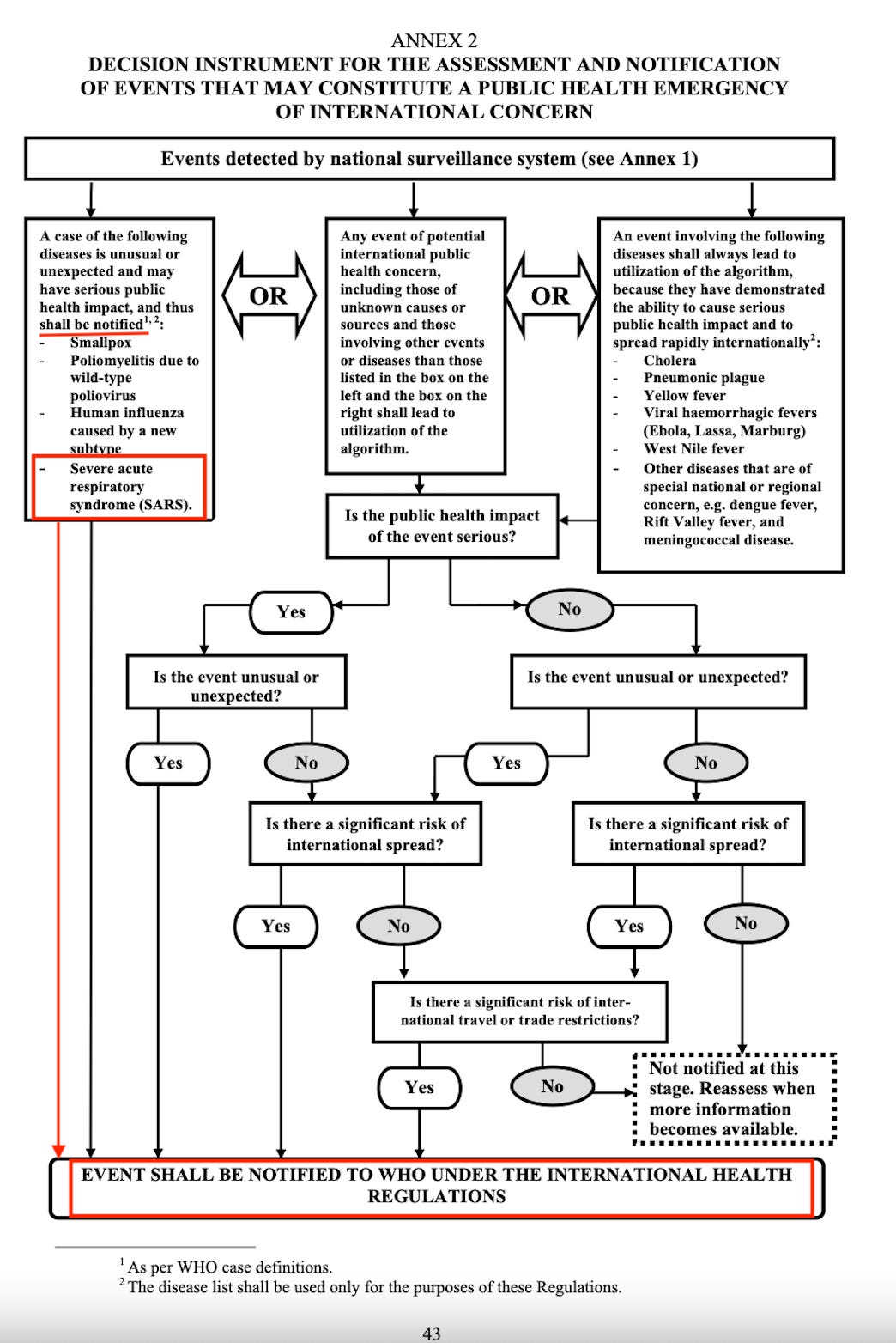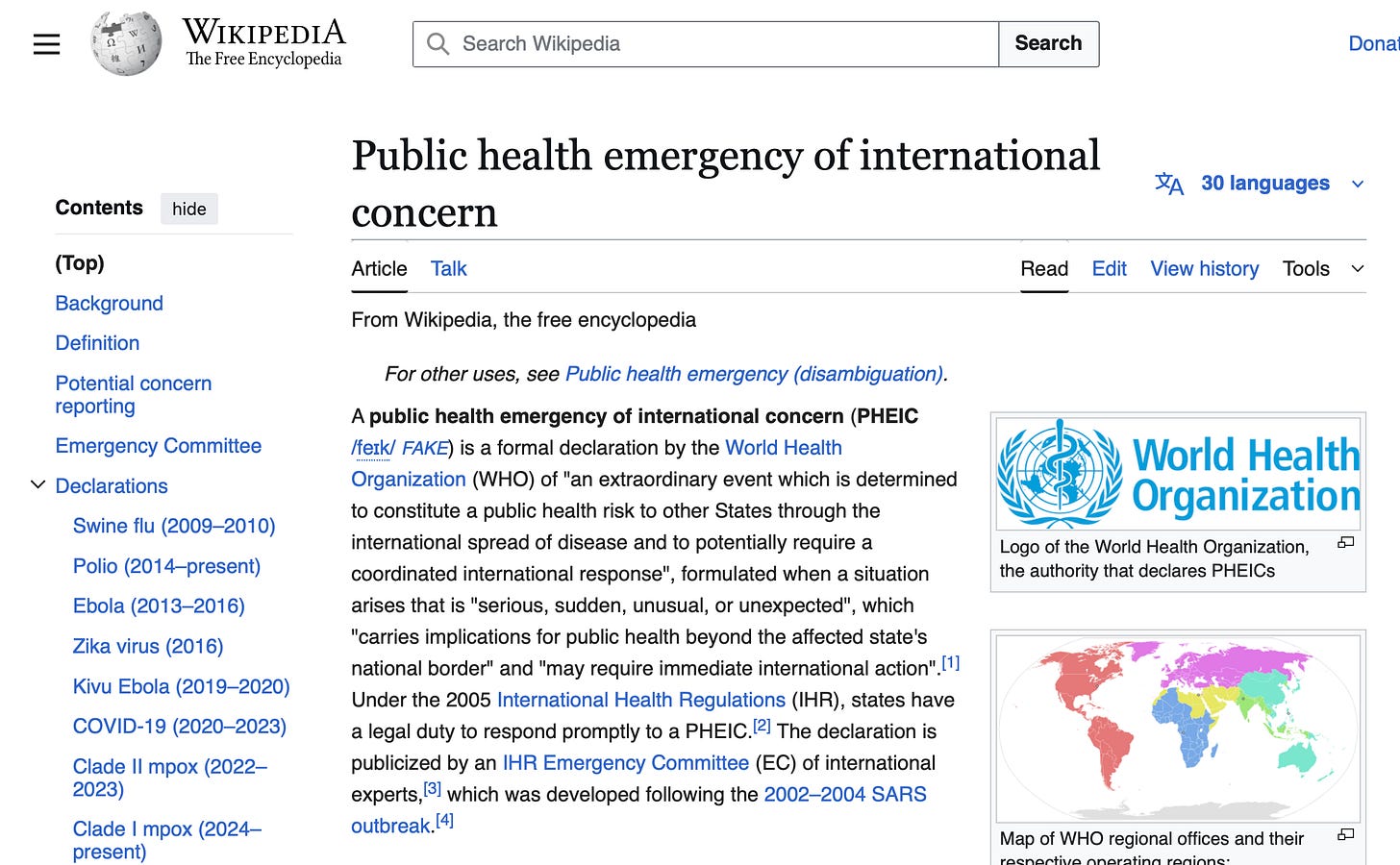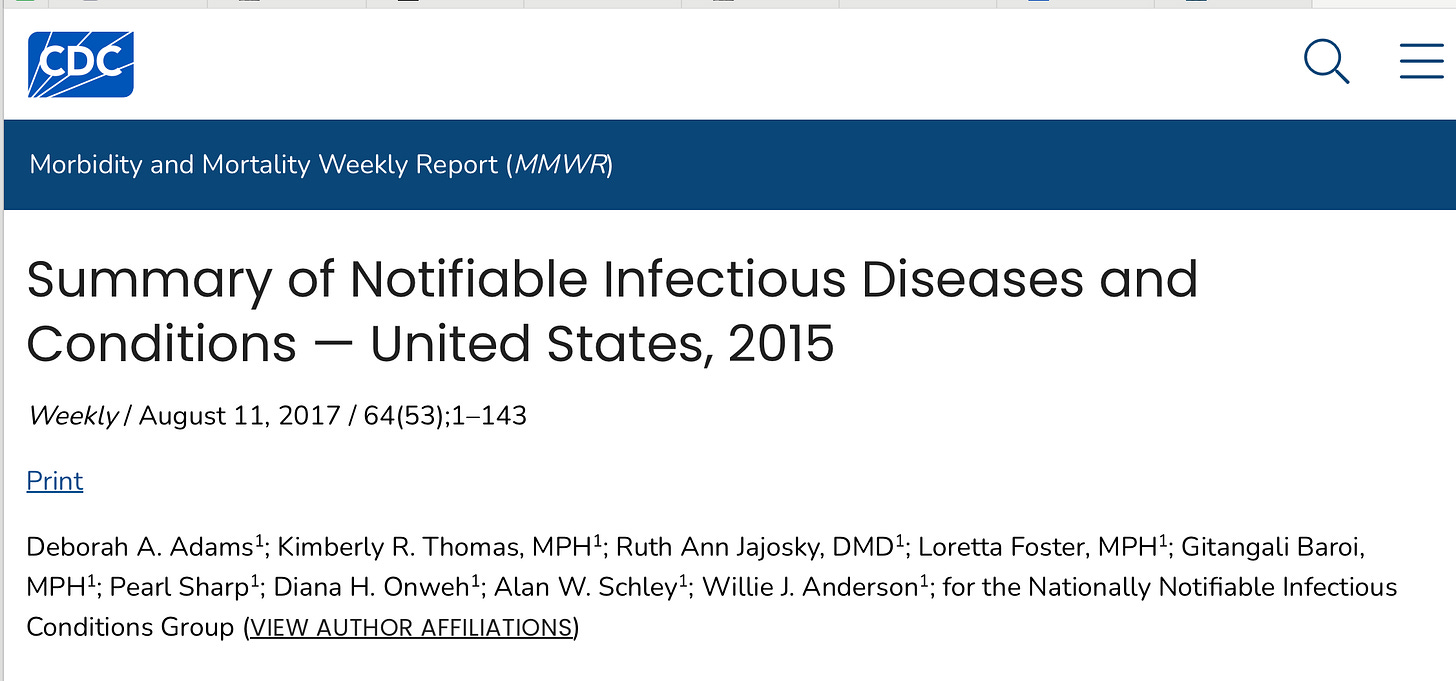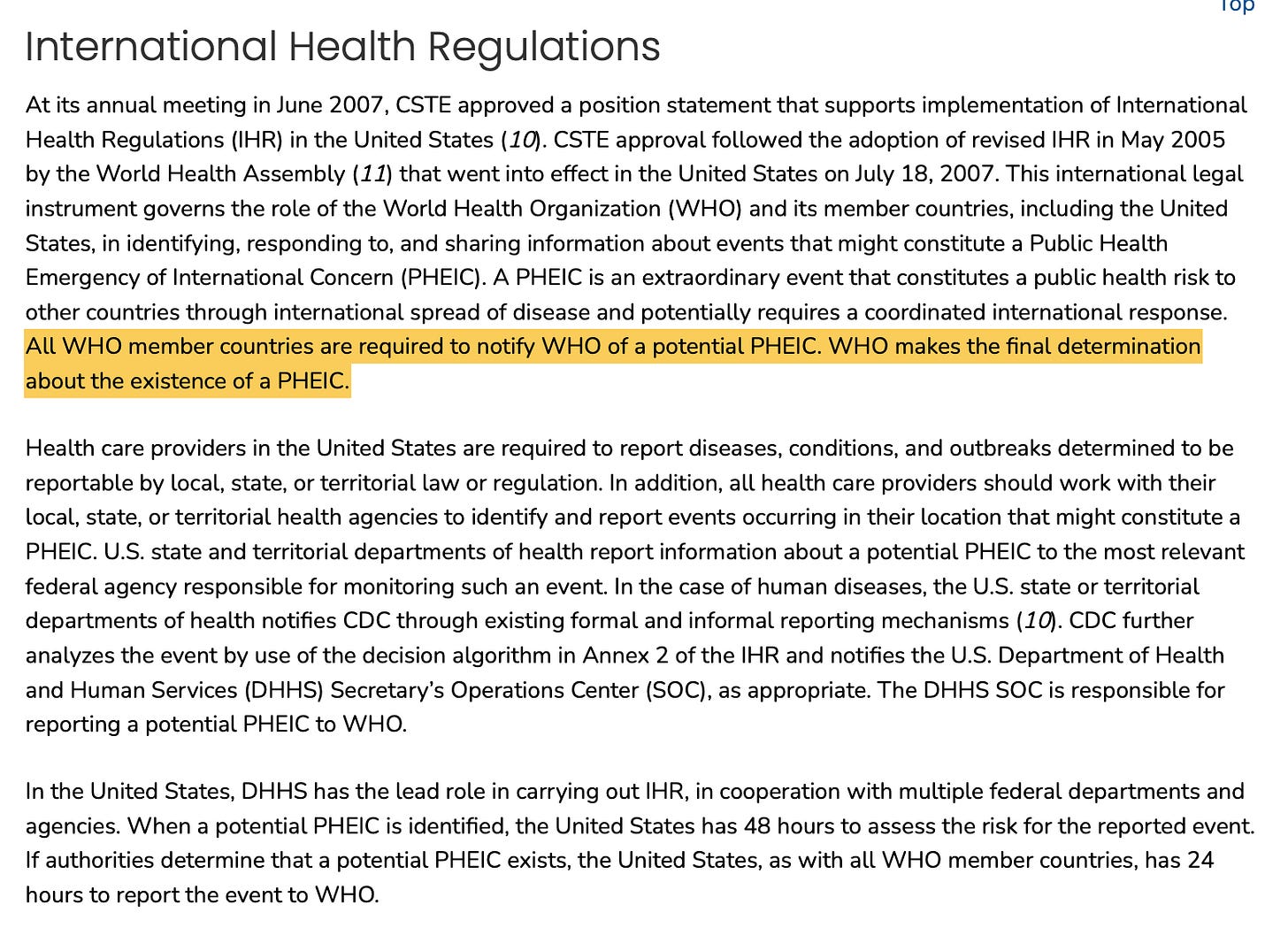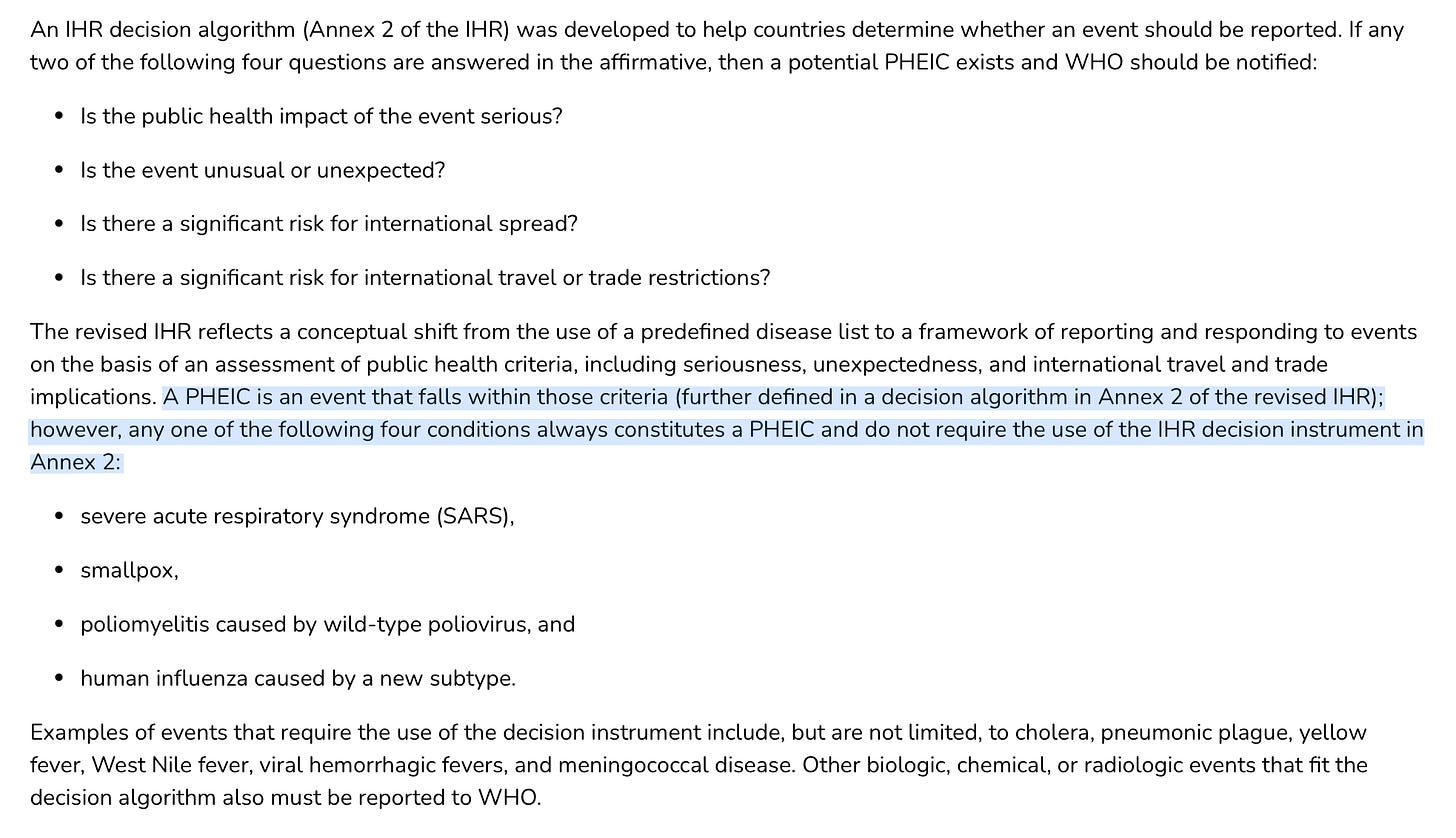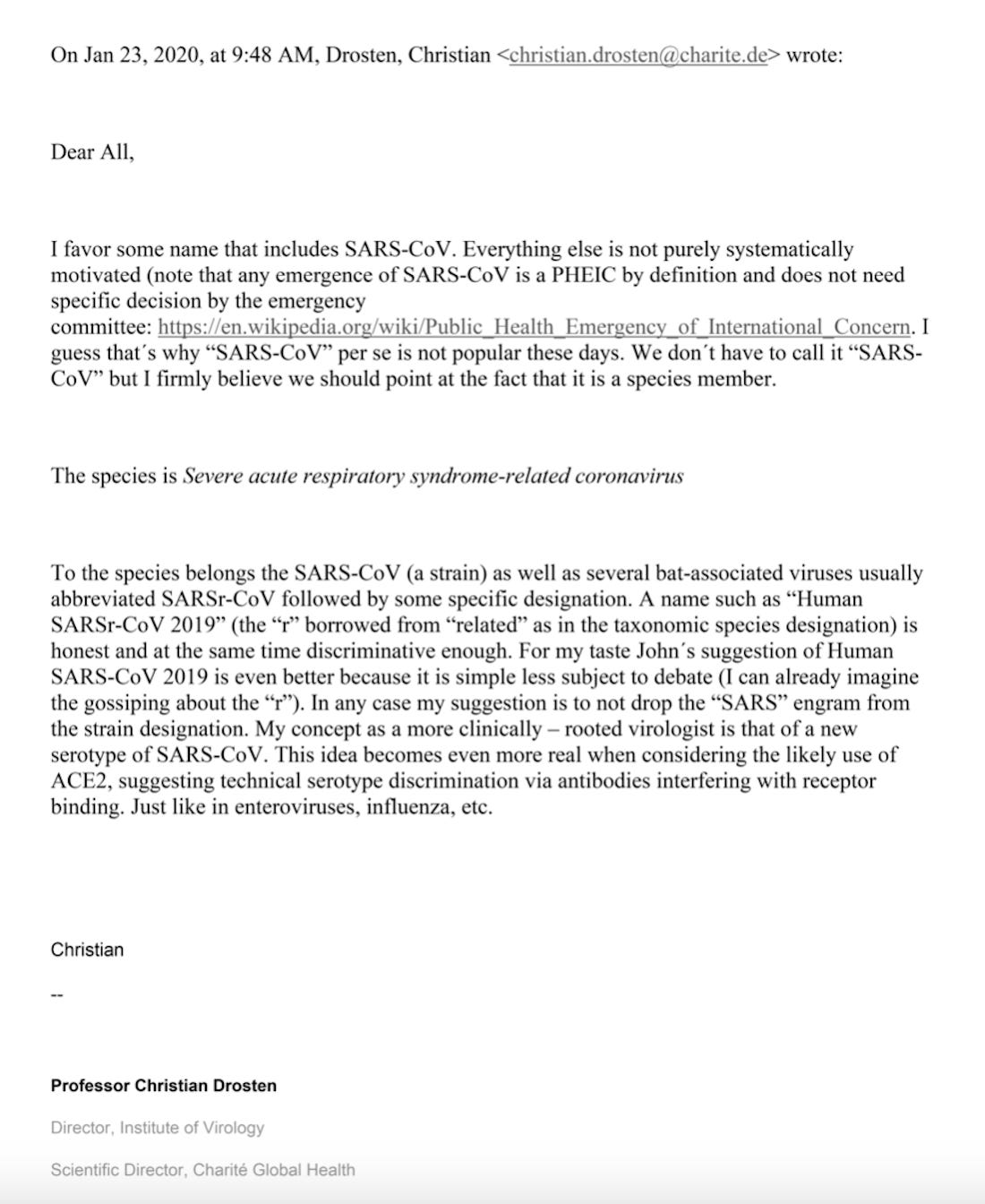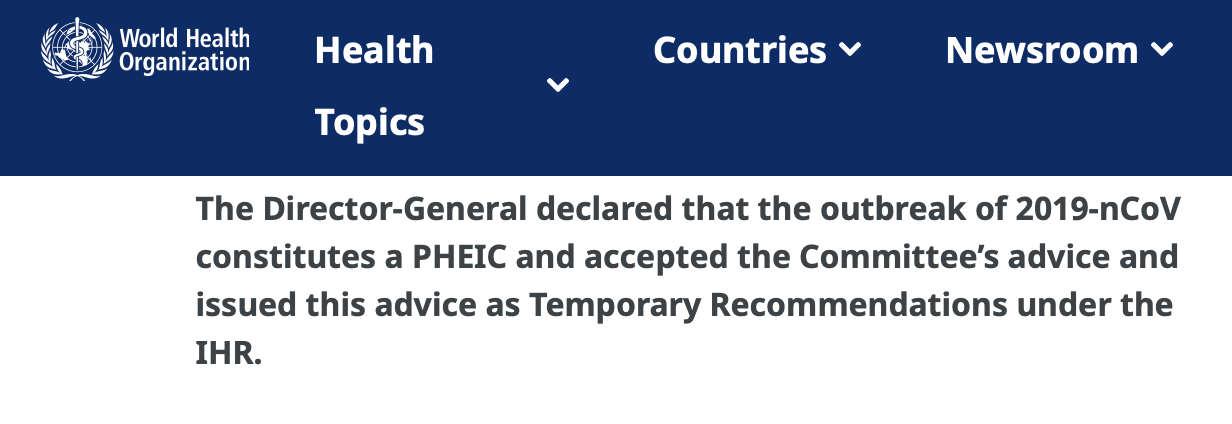Does a SARS virus automatically trigger a WHO Public Health Emergency of International Concern (PHEIC)?
Fact-checking a claim made by Christian Drosten on 23 January 2020
Revisiting an article I wrote last year on the naming of SARS-CoV-2 reminded me of a claim by Christian Drosten that warrants a “fact check.”
Drosten, a key architect of the “blueprint” testing protocols for both SARS-1 and SARS-CoV-2, served on the International Committee on the Taxonomy of Viruses Coronavirus Study Group (ICTV-CSG), which was tasked with classifying and renaming 2019-nCoV in January 2020.
The group’s deliberations were conducted via email and focused largely on the social and political implications of including “SARS” in the virus’s official name. There was no real dispute that the identified sequence(s) belonged to the species severe acute respiratory syndrome-related coronavirus.
On 23 January 2020, Drosten said,
I favor some name that includes SARS-CoV. Everything else is not purely systematically motivated (note that any emergence of SARS-CoV is a PHEIC by definition and does not need specific decision by the emergency
committee:https://en.wikipedia.org/wiki/Public_health_emergency_of_international_concern.) I guess that's why "SARS-CoV" per se is not popular these days. We don't have to call it "SARS-CoV" but I firmly believe we should point at the fact that it is a species member.
Was Drosten right? Does any emergence of a SARS-CoV trigger a Public Health Emergency of International Concern (PHEIC, pronounced ‘fake’) — no separate Emergency Committee decision required?
To find out, I looked into what a PHEIC is and how one gets declared.
PHEIC Defined
Per WHO-IHR (2005), a Public Health Emergency of International Concern (PHEIC) is
"an extraordinary event which is determined as provided in these Regulations (i) to constitute a public health risk to other States through the international spread of disease and (ii) to potentially require a coordinated international response."1
Every word in the definition warrants scrutiny, but two terms are key: spread and disease. A disease of a certain kind or characteristics must be
detected via a national surveillance system,
spreading within a country, and
shown or assumed to pose a risk of spreading to other countries.
Annex 2 of the IHR provides a DECISION INSTRUMENT FOR THE ASSESSMENT AND NOTIFICATION OF EVENTS THAT MAY CONSTITUTE A PUBLIC HEALTH EMERGENCY OF INTERNATIONAL CONCERN.
The top-left box of the instrument says a case (implied: a single case) of
smallpox,
polio (wild type-related),
human influenza (new subtype), and
severe acute respiratory syndrome (SARS)
is necessarily “unusual or unexpected, and may have serious public health impact, and thus shall be notified.”2
Based on the title of the instrument and the box at the bottom of the page, “notified” means notification to the WHO (and WHO emergency committee) that there’s an event which may constitute a PHEIC. Hence, the language employed seems to suggest that Drosten was incorrect when he said the emergence of anything SARS-related results in an automatic PHEIC and renders the Emergency Committee perfunctory.
However, the Wikipedia page Drosten cited in his email said otherwise. All versions of the page for 23 January 2020 read,
“SARS, smallpox, wild type poliomyelitis, and any new subtype of human influenza, are always a PHEIC and do not require an IHR decision to declare them as such.”3
This statement was added to the Wikipedia entry on 19 June 2019.4 The source referenced is a 2018 publication: p. 908 in Chapter 8, “Public Health Law,” in the 9th edition of Health Care Law and Ethics (Hall, et al, 2018) — which excerpts content from a CDC report “Summary of Notifiable Infectious Diseases and Conditions — United States, 2015” (pub 11 Aug 2017).
The report makes clear that the IHR is an “international legal instrument that governs the role of the [WHO] and its member countries including the U.S., in identifying, responding to, and sharing information about an events that might constitute a PHEIC,” with WHO making the final determination as to whether a PHEIC exists. It also presents Annex 2 of the IHR (the decision instrument) as a tool for countries to use.5
We see a statement similar — but not identical — to the one in the Wikipedia entry Drosten accessed: that any one of the four conditions always constitutes a PHEIC and does not require use of the IHR decision instrument in Annex 2, versus the claim that they always constitute a PHEIC and do not require an IHR committee decision to declare them as such.
It seems the CDC interprets the mere emergence of SARS as sufficient to trigger a PHEIC. The confusion between a PHEIC not requiring an IHR committee decision and not requiring use of the IHR decision instrument may simply reflect a misreading by the Wikipedia author. In any case, I see nothing in the WHO IHR (2005) stating that a single case of [insert disease] automatically constitutes a PHEIC — or, for that matter, that the Emergency Committee is in a decision-making role versus an advisory the WHO Director General.
I emailed the corresponding author, Kristin Thomas, last week about the CDC’s interpretation but haven’t received a response.
What of Drosten?
What should we make of Christian Drosten telling the virus-naming committee that anything labeled SARS-CoV constitutes a PHEIC? It’s hard to say for sure, but the date, 23 January, is notable for two reasons.
First, 23 January was the same day Detection of 2019 novel coronavirus (2019-nCoV) by real-time RT-PCR was published in Eurosurveillance. As a lead designer of that WHO-endorsed PCR protocol, Drosten had clear professional incentives for a public health emergency—and eventually a pandemic—to be declared.
He and his co-authors explicitly stated they had relied on social media reports suggesting a SARS virus was involved in the Wuhan “outbreak.” This aligns with an April 2020 Science article, which reported that early “rumors about a coronavirus” prompted lead author Victor Corman to search existing SARS-related bat coronavirus sequences in order to “guess what parts of a new SARS-like coronavirus might look like” for test design purposes.
Because a PHEIC requires the threat of international spread—not merely detection of something “new”—the PCR test was central to manufacturing the appearance of a transmissible pathogen crossing borders, just as it was during SARS-1 and H1N1. As Drosten himself admitted in a 13 March 2020 interview:
“You have to be clear that if we didn't test, then in many countries we wouldn't even know that this virus even exists.”
Second, his 23 January email coincided with Day 2 of the WHO Emergency Committee’s initial meeting on the “outbreak of novel coronavirus (2019-nCoV).” According to the statement that followed, several unnamed committee members felt it was “still too early to declare a PHEIC, given its restrictive and binary nature.” That same concern resurfaced during the second meeting on 30 January—after which the PHEIC was declared.
The Emergency Committee meeting summaries make clear that members were told human-to-human transmission of 2019-nCoV was occurring. Less clear is whether they were informed—or discussed—that 2019-nCoV was believed to belong to the species severe acute respiratory syndrome-related coronavirus.6
WHO situation reports from January 2020 don’t mention SARS, likely because—according to emails and other documents—WHO officials were intentionally avoiding the term. Still, several sources available by the time the committee met suggest the connection to SARS was known or inferable: the Corman-Drosten PCR protocol, a CDC China report posted on 21 January, relevant news coverage, and internal communications
Did it have to be SARS?
While I don’t read the WHO IHR (2005) as stating that a single case or emergence of SARS-CoV automatically constitutes a PHEIC, the belief that it did may have helped create a sense of inevitability among those responsible for naming the virus.
Given that SARS is on the short list of conditions flagged as potential global emergencies, one has to ask: Did the coronavirus linked to “pneumonia of unknown etiology in Wuhan” need to be classified as SARS-related? And is it possible Christian Drosten and others were tapped because they could be trusted to deliver the test needed to ‘fake a PHEIC’?
Whatever happened, it’s obvious that decisions made in those weeks were anything but neutral — and helped stage the appearance of a pandemic.
Related
Nothing in this article should be taken to mean I endorse the notion of a PHEIC; I don’t and reject the assertion that there can be public health emergencies of international concern .
In October 2012, the U.S. National Select Agent Registry Program declared “SARS-coronavirus” a select agent, i.e., a bacterium, virus or toxin that has the potential to pose a severe threat to public health and safety.
The version posted as of 10 July 2025 says, “Automatically, SARS, smallpox, wild type poliomyelitis, and any new subtype of human influenza are considered as PHEICs and thus do not require an IHR decision to declare them as such.” https://en.wikipedia.org/wiki/Public_health_emergency_of_international_concern Statement added 18 June 2019, 14:10, Universal https://en.wikipedia.org/w/index.php?title=Public_health_emergency_of_international_concern&action=history&dir=prev&limit=500
Why the Wikipedia entry for PHEIC was amended in June 2019 with this statement is hard to say. Considering potentially related events on the U.S. side, it was the same month during which syndromic surveillance in the state of Illinois showed an off-season increase in ED visits for unexplained respiratory illness among younger males, which was later interpreted as a “signal” for vaping-related illness. (See figure 3 in Leyden et al, 2019). UPDATE 7 August 2025. Regarding the potential significance of June 2019, via Substack Note
added that June 2019 is when Congress and President Trump passed the Pandemic and All-Hazards Preparedness and Advancing Innovation Act in June 2019, which amended or added several relevant provisions that would then come into play as the Covid performance began in late 2019 and early 2020. One change included adding language (pertaining to PHE determinations, declarations and authorization for use of Public Health Emergency Fund by the HHS Secretary) — ‘‘or if the Secretary determines there is the significant potential for a public health emergency” — to 42 U.S.C. 247d; 42 U.S.C. 300hh– 11; 247d–7e; and 21 U.S.C. 357(c)(3). Congress had already added the phrase “significant potential for a public health emergency” to 21 USC 360bbb-3 in 2013, through the Pandemic and All-Hazards Preparedness Reauthorization Act of 2013. Adding the phrase “significant potential for” gave the perpetrators access to another layer of abstraction (information not dependent on presentation of validated material or physical evidence.)At the U.S. federal level, the Department of Health and Human Services
WHO had begun calling the entity 2019-nCoV by 10 January 2020. The Chinese had said Wuhan seafood market pneumonia virus isolate “Wuhan-Hu-1”

